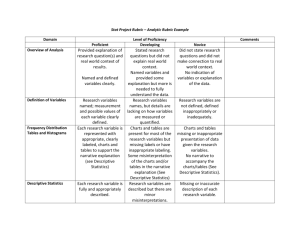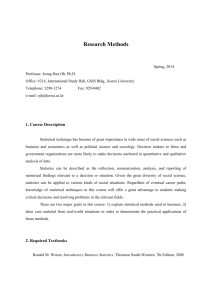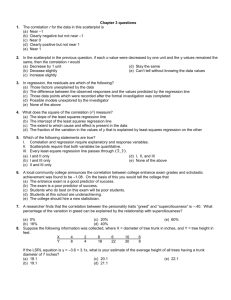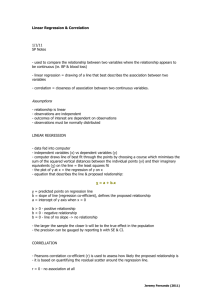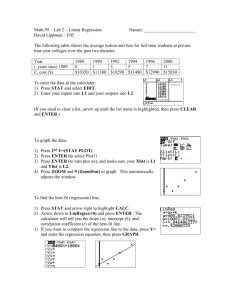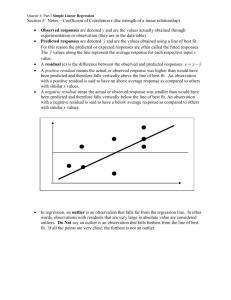When the four areas (critical components) identified in the graphic
advertisement
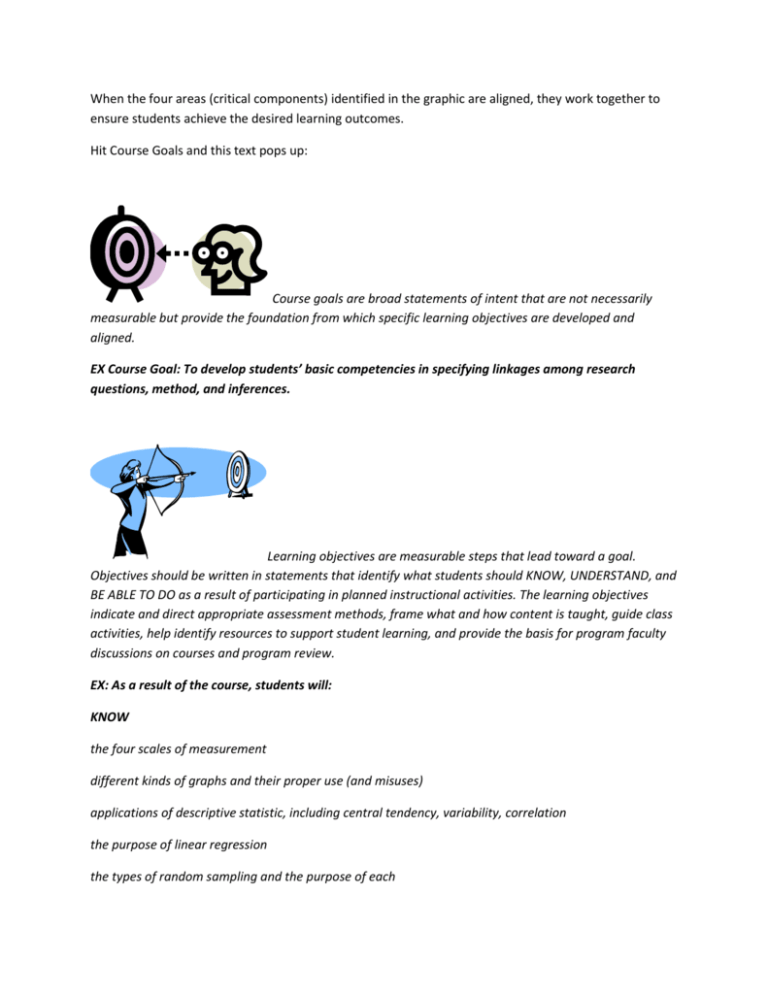
When the four areas (critical components) identified in the graphic are aligned, they work together to ensure students achieve the desired learning outcomes. Hit Course Goals and this text pops up: Course goals are broad statements of intent that are not necessarily measurable but provide the foundation from which specific learning objectives are developed and aligned. EX Course Goal: To develop students’ basic competencies in specifying linkages among research questions, method, and inferences. Learning objectives are measurable steps that lead toward a goal. Objectives should be written in statements that identify what students should KNOW, UNDERSTAND, and BE ABLE TO DO as a result of participating in planned instructional activities. The learning objectives indicate and direct appropriate assessment methods, frame what and how content is taught, guide class activities, help identify resources to support student learning, and provide the basis for program faculty discussions on courses and program review. EX: As a result of the course, students will: KNOW the four scales of measurement different kinds of graphs and their proper use (and misuses) applications of descriptive statistic, including central tendency, variability, correlation the purpose of linear regression the types of random sampling and the purpose of each UNDERSTAND Statistics is a useful language for symbolically modeling quantitative data and thus simplifying and analyzing our world Data consists of structure plus variability Statistics can be used to make valuable, reliable inferences from quantitative data The appropriate communication and interpretation of statistics is essential to avoid statistical abuse and/or misunderstanding BE ABLE TO DO *Engage in statistical problem solving *To randomly select a sample from a population *Perform the following procedures using statistical software Recode existing variables in a dataset and generate new variables from existing variables Produce descriptive statistics including frequency distributions, measures of central tendency, measures of variability, and graphs such as histograms, box plots, and scatterplots Perform a test of statistical significance to assess the relationship between two quantitative variables and interpret and communicate the results in writing Construct a prediction model using simple linear regression and interpret the resulting values. Choose and apply appropriate inferential analyses to real situations in order to draw conclusions about a population. Recognize the strengths and limitations of quantitative data analysis and quantitative research methods *Communicate using scholarly language (i.e., APA writing guidelines) the analyses, the results of the analyses, and the interpretation and conclusion of the analyses. Student outcomes are the specific observable and measureable skills, attitudes, and/or knowledge that students demonstrate that provide evidence that intended learning has occurred as a result of the instructional activities. EX: How Measured BACKGROUND NOTE: Two exams are given to assess students’ obtainment of the learning objectives in a de-contextualized manner. The project is intended to provide students the opportunity to engage in a real-life situation of asking a research question, designing a study to address that research question, and carrying out the study. The project is the culmination of the semester long instructional cycle. I. Exam 1: exam 1 will focus on the following learning objectives identified below. Know: the four scales of measurement different kinds of graphs and their proper use (and misuses) applications of descriptive statistic, including central tendency, variability, correlation APA writing guidelines for reporting statistical analyses Be Able To Do: *Perform the following statistical procedures using statistical software Recode existing variables in a dataset and generate new variables from existing variables Produce descriptive statistics including frequency distributions, measures of central tendency, measures of variability, Pearson’s correlation and graphs such as histograms, box plots, and scatterplots Interpret the descriptive analyses (above) resulting values and draw conclusions using APA writing guidelines II. Exam 2: exam 2 will focus on the following learning objectives: Be Able To Do: *construct a prediction model using simple linear regression and interpret the resulting values and communicate in scholarly language the meaning of the resulting model. *perform a test of statistical significance to assess the relationship between two quantitative variables and interpret and communicate the results in writing. III. On-going Course Project There will be a project for the course that will last the entire length of the course. The project is a way for you to put to use all of the ideas covered in the course to study a topic of your interest. You will secure data, generate hypotheses, analyze the data, and draw conclusions using the tools and procedures that are presented in class. There will be deadlines for each part of the project. However, the final component of project will be due <DATE>. The outline below describes each of the components of the project: 1. Decide on a topic that is of interest to you that has some significance and requires quantitative data (nominal through interval/ratio). Due by: <DATE> If you do not have access to a dataset, please inform the instructor. 2. DUE <DATE>: Collect data that are suitable for descriptive statistics and hypotheses testing. 3. DUE <DATE>: Central Tendency & Variability; Write-up 4. DUE <DATE>: Correlation & Regression; Write- up 5. DUE <DATE>: Hypothesis Testing, including research question, Regression Analysis; Write-up Show Project Rubric Your project paper should include: a. An introduction to each question that you are trying to address. b. An explanation, in detail, of what you did to answer your question (including a description of your data) and why you chose this method. c. A presentation of your data using a variety of appropriate methods; charts/graphs/tables (all done following scholarly formatting) c. All the statistical analyses necessary to answer your question. This includes checking conditions for inference. e. A conclusion and a contextualized interpretation based on the results. f. Limitations (Include a discussion on how your project could be improved.) (Note: Over the course of the semester you will have several different types of analyses and as we move into the inferential component of the course, you may need to go back and revisit some of your conclusions based on more sophisticated analyses. You will be evaluated based on the soundness of your statistical thinking, the correctness of your statistical procedures, the presentation of your statistical procedures, and the professional presentation of your work. Stat Project Rubric – Analytic Rubric Example Domain Proficient Overview of Analysis Provided explanation of research question(s) and real world context of results. Named and defined variables clearly. Definition of Variables Frequency Distribution Tables and Histograms Descriptive Statistics Research variables named; measurement and possible values of each variable clearly defined. Each research variable is represented with appropriate, clearly labeled, charts and tables to support the narrative explanation (see Descriptive Statistics) Each research variable is fully and appropriately described. Level of Proficiency Developing Stated research questions but did not explain real world context. Named variables and provided some explanation but more is needed to fully understand the data. Research variables names, but details are lacking on how variables are measured or quantified. Charts and tables are present for most of the research variables but missing labels or have inappropriate labeling. Some misinterpretation of the charts and/or tables in the narrative explanation (See Descriptive Statistics) Research variables are described but there are minor misinterpretations. Comments Novice Did not state research questions and did not make connection to real world context. No indication of variables or explanation of the data. Research variables are not defined, defined inappropriately or inadequately. Charts and tables missing or inappropriate presentation of data given the research variables. No narrative to accompany the charts/tables (See Descriptive Statistics). Missing or inaccurate description of each research variable. Pearson’s Correlation Coefficient Scatter Plot Linear Regression Confidence Intervals The correlation coefficient and its interpretation (e.g., not causation) are correctly reported, Scatter plot is present and correct; wellillustrated, scaled, and readable, axes are labeled, and there is a discussion of connections to the correlation coefficient, r Regression line and equation are both correct; slope is reported and interpreted accurately; R2 is reported and interpreted accurately. A prediction example relevant to the identified context is used to demonstrate the regression equation. The correlation coefficient is reported but it is misinterpreted (e.g., linked to causation, Scatter plot is present and correct but there are issues with the illustration, scalability, and/or labeling. There is not a discussion of the connection to the correlation coefficient, r Regression line is present and correct; regression equation is reported and is correct; slope is reported correctly and the interpretation is partially correct. R2 is reported correctly and interpretation is partially correct. Confidence interval presented with correct interpretation to Confidence interval presented but missing interpretation or Correlation coefficient is not reported or incorrect; incorrect or inadequate explanation of the Scatter plot missing, or incorrect (e.g., confusion between predictor and criterion variables). No connection to the correlation coefficient, r Regression line is missing, incorrect, or poorly illustrated; equation of regression line not reported and inadequately explained or not explained at all. Slope of regression line is not reported correctly and/or the interpretation of the slope is incorrect. R2 is completely missing from Discussion. Missing confidence interval or explanation missing or inappropriate context Testing of Means Hypothesis Testing Procedure Discussion inappropriate is provided. interpretation provided. Appropriate t-test Appropriate t-test Inappropriate t-test implemented to address implemented to address implemented and/or no stated hypotheses; stated hypotheses; consideration of consideration of incomplete statistical assumptions. statistical assumptions consideration of provided. statistical assumptions provided. Null and alternative Null and/or alternative Hypotheses are missing hypotheses are clearly hypotheses are stated or are inappropriately and correctly stated with some inappropriate stated (incorrect using appropriate use of statistical symbols). statistical symbols. symbols. Incorrect statistical An appropriate An appropriate procedure is statistical test is statistical test is implemented to address implemented correctly. implemented but the hypotheses. Correct conclusions are conclusions drawn Incorrect conclusions drawn based upon the based upon obtained are drawn based upon obtained critical value. critical value are the obtained critical Interpretation of the incorrect. value or conclusions are conclusion relative to Misinterpretation of the completely missing. the hypotheses in conclusions and/or Misinterpretation of the clearly stated and lacking contextualization conclusion relative to accurate within the and connection back to the hypotheses with no given context. No the hypotheses. contextualization or unwarranted connection of the stated conclusions. hypotheses. Discussion of results is Adequate discussion of Implications of results insightful; adds meaning results but limited not discussed; no and significance to the reflection into why the attempt to explain Presentation findings. results occurred. findings. Report draws unwarranted conclusions or uses inappropriately certain language (e.g., “we proved”). The document is written with logic, clarity, and precision using scholarly language. The text is logical and coherent. There is consistent application of the scholarly writing and publication guidelines. The document tends to be logically organized but there is a lack of precision and clarity. The use of scholarly language is sporadic throughout the document. Inconsistent or inappropriate application of scholarly writing and publication guidelines. The document is not written in a scholarly fashion or lacks precision and clarity. Failure to follow scholarly writing and publication guidelines.
